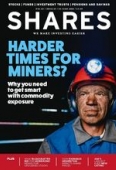Archived article
Please note that tax, investment, pension and ISA rules can change and the information and any views contained in this article may now be inaccurate.
How earnings upgrades can boost stock returns

In this article we are going to look at bold earnings revisions and explore if they help identify winning stocks. In this context ‘bold’ refers to a large percentage change in a consensus earnings forecast, as well as the rarer, but possibly more important case where a top-rated analyst moves significantly away from the consensus.
We have also run the data and identified three stocks to buy which could be at the beginning of an earnings upgrade cycle.
UNDERSTANDING THE EARNINGS EFFECT
In order to explain what’s at work here, we need to delve a little into what is called behavioural science, popularised by Daniel Kahneman and Amos Tversky in the 1960’s.
Even back in the 1930’s economist John Maynard Keynes was acutely aware that human psychology could have a big impact on investing, where decisions are made under extreme uncertainty.
Keynes likened professional investing to an old-fashioned beauty contest where competitors must pick the six prettiest faces from 100 photos.
The closest match to the average of all the competitors was awarded the winner. This meant that it was more important to choose the picture that you thought would be the most popular, rather than focus on your own choice.
Arguably modern-day fund managers still operate in the same way, often choosing stocks that fit a particular style or narrative which they believe other managers will find attractive a few months down the line.
BOLD REVISIONS AND HERDING
Looking in from the outside it would seem reasonable to expect earnings forecast to 100% reflect a particular analyst’s view. But the reality is slightly distorted from this ideal world.
When analysts make their forecasts, they are all too aware of where their estimate sits relative to their peers. It is this dynamic which creates a strong ‘group think’ or herding mentality.
To quote from Keynes, ‘worldly wisdom teaches that it is better for reputation to fail conventionally than to succeed unconventionally’.
In other words, analysts feel a natural psychological pull towards the herd, and therefore tend not to stray too far away from consensus (the equal weighted average of all analyst recommendations).
In practice this means that analysts are more inclined to tinker with their spreadsheets rather than ‘stick their necks on the block’ and make change which is significantly different from the crowd.
Given this tendency, research has shown when an analyst moves his or her earnings estimate away from the herd, it may be an important signal for future stock performance.
In his book Investment Philosophies, Professor Aswath Damodaran highlighted that forecast revisions that diverge the most from consensus have a bigger impact on price and are more likely to be accurate than revisions that stay close to the pack.
Like all pack animals, humans work best when there is a leader and often, although unspoken, there will be a ‘lead’ or superior analyst in each sector.
Recognising that there will always be a hierarchy among analysts, in the 1990’s Joe Gatto set out to quantitively find a better way of measuring the accuracy of analysts’ forecasts.
The company Starmine was born out of Gatto’s efforts and in 2008 the company was purchased by Reuters (now Refinitiv).
Starmine places different weights on each analysts’ forecast based on their historical accuracy and the most recent revisions, rather than equal weighting each forecast.
When the Starmine consensus estimate is more than 2% away from the regular IBES (Institutional Brokers Earnings Estimate) constructed consensus forecast, Starmine claims that there is 70% chance of a positive/negative earnings surprise.
Refinitiv says analyst skills are persistent and the top analysts are roughly four times more likely to remain among in the top tier than fall to the bottom tier.

SCREENING FOR REVISIONS
Our investment focus for this article is long term, so we are have looked for situations where there is potentially a sustainable improvement in earnings, rather than a short term ‘beat’.
Consequently, we have taken the approach of searching for shares where analysts have materially increased their estimates, suggesting growth prospects are greater than expected.
Some of these revisions look fairly modest in isolation but what we have tried to capture is the start of an upward earnings revisions cycle which can be a powerful driver of returns. The behavioural factors we have discussed mean that it can take quite a while for analysts to catch up, sowing the seeds for further upgrades.
Using Stockopedia, we searched the market for companies which have received the biggest revisions over the last month, where at least two analysts have upgraded their numbers.
We have chosen three of the best from the list of candidates based on the quantitative data, as well as our qualitative assessment of company fundamentals and outlook for the respective businesses.
Morgan Advanced Materials (MGAM)
353p

Like several of the UK’s engineering businesses, Morgan Advanced Materials (MAGM) is far from a simple metal basher.
It designs smart materials to create more advanced and energy efficient products and has significant technological expertise.

The company is part way through a programme of self-help under a management team which joined in the mid-2010s. This is driving improvement in margin performance which, allied with a recent broad based recovery in sales and orders coming out of the pandemic, is creating some momentum behind earnings forecasts.
The shares trade at around 15 times Jefferies’ forecast earnings per share in 2021, falling to 12.7 times for 2022 and Jefferies’ analyst team comment: ‘It is difficult to find value in the UK industrials sector, yet we argue that Morgan offers compelling value at current levels, and we see the group evolving positively, which should positively impact the group’s valuation over the medium term.’
Redde Northgate (REDD)
Price: 393.3p
 Light commercial vehicle rental and legal services firm Redde Northgate (REDD) is riding a huge wave of demand in both the UK and Spain with its fleet of vehicles on hire growing by more than 10% this year.
Light commercial vehicle rental and legal services firm Redde Northgate (REDD) is riding a huge wave of demand in both the UK and Spain with its fleet of vehicles on hire growing by more than 10% this year.
Four out of seven analysts that cover the stock have increased their earnings forecast over the last month.

As the pandemic accelerated consumers’ adoption of online ordering and home delivery, demand for LCVs has never been stronger, which has helped the firm raise hire rates and boosted the resale value of its used vehicles.
Costs have been reined in, and merger synergies have reached the company’s £15 million target a year ahead of schedule. Total annualized cost savings are now expected to be £18.8 million, at a cost of just £2.5 million against an original estimate of £10 million.
The firm’s prodigious cash flow generation has allowed it to invest in a large fleet of UK vehicles, which will add to growth this year meaning earnings upgrades are likely to continue well into the second half.
Tyman (TYMN)
463.7p
 Like several businesses in the building materials sector, Tyman (TYMN) has real momentum behind its business driven by a boom in housebuilding and renovation work. This makes a 2021 price to earnings ratio of 14.7 look attractive.
Like several businesses in the building materials sector, Tyman (TYMN) has real momentum behind its business driven by a boom in housebuilding and renovation work. This makes a 2021 price to earnings ratio of 14.7 look attractive.

The company makes highly engineered products like hardware for windows and doors, smart entry and monitoring products, as well as seals and extrusions and access solutions for commercial buildings.
Most of its brands are leaders in their respective markets and are well known by industry professionals. Its largest market is the US, which accounted for 65% of 2020 revenue.
The company has a track record of making bolt-on acquisitions to build its share of a fragmented market, although this was paused in 2019 to focus on organic growth and this pause was extended due to the pandemic.
The company may now return to targeted M&A activity, which should help support the current earnings momentum. The main risk facing the business is the current shortage of raw materials.
Important information:
These articles are provided by Shares magazine which is published by AJ Bell Media, a part of AJ Bell. Shares is not written by AJ Bell.
Shares is provided for your general information and use and is not a personal recommendation to invest. It is not intended to be relied upon by you in making or not making any investment decisions. The investments referred to in these articles will not be suitable for all investors. If in doubt please seek appropriate independent financial advice.
Investors acting on the information in these articles do so at their own risk and AJ Bell Media and its staff do not accept liability for losses suffered by investors as a result of their investment decisions.

 magazine
magazine








